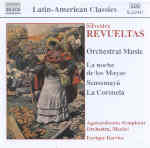Naxos has earned a well-deserved reputation for championing rarely recorded repertoire, but one of the colder facts in today’s marketplace is that even unusual works often enjoy multiple representation, and a second rate recording (such as this) that at one time would have seemed “good enough at the price” no longer holds much appeal, particularly when comparative listening reveals its palpable inferiority to the competition. Take the two big works. La noche de los Mayas can be had in at least four previous recordings (Salonen/Sony, Mata/RCA, Bátiz/ASV, and Lozano/Forlane), all of them better than this one in terms of playing and interpretation. You only have to note the restrained massed percussion and asthmatic brass in the variation-coda of “Noche de encantamiento” to hear what this performance lacks in vibrancy and impact next to those others.
Similarly, La Coronela exists in two prior recordings, both more interesting than this newcomer (and much of the music really isn’t first-rate Revueltas to begin with). The ballet, left very incomplete at the composer’s death, consists of three tableaux orchestrated from piano sketches and a fourth subsequently cobbled together from various unrelated film scores to complete the original scenario. Enrique Arturo Diemecke’s version on Sparticus intelligently adds some additional linking material and enjoys superior orchestral playing from the Orquesta Sinfonica Nacional de Mexico. And as for Gisèle Ben-Dor’s superb recording with the similarly fine Santa Barbara Symphony on Koch, about two seconds into the opening number (“Los Privilegiados”) it’s clear that her swifter tempos, punchier accents, tighter rhythm, and superior wind soloists guarantee a more idiomatic Revueltas experience.
Regarding Sensemayá, the most frequently encountered Revueltas work both in concert and on disc, the best performances (Mata/RCA and Bernstein/Sony) generally take just under six minutes. If the piece lasts much longer than that, you need a virtuoso orchestra and conductor to sustain the music’s rhythmic tension. Salonen and the Los Angeles Philharmonic offer just that at bit less than seven minutes. At 6:46 (the track listing says 6:53), Enrique Barrios and his clearly provincial Aguascalientes Symphony Orchestra, even with the best will in the world, can’t compare.
Doubtless many music lovers (not to mention critics) unfamiliar with this composer may encounter this disc and indeed find it “good enough at the price”, but if you really care about one of the most original creative figures in 20th century music, why settle for second (or in this case third and fifth) best? Go for Salonen in La noche de los Mayas and Sensemayá, and Ben Dor for La Coronela, or better still bag this last item entirely and grab RCA’s two-disc vintage Revueltas collection while you still can. You can only gain in personal enjoyment if you give this composer a chance to make the most powerful initial impression, and for that you simply have to buy the best.
































